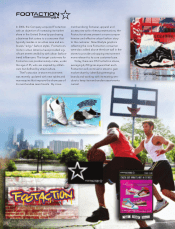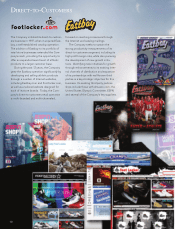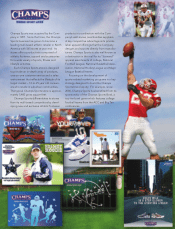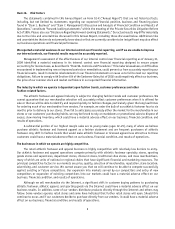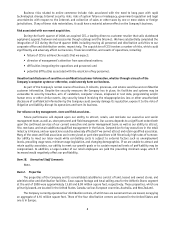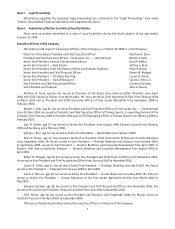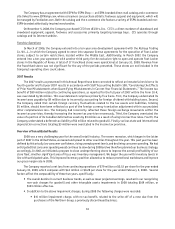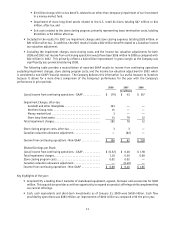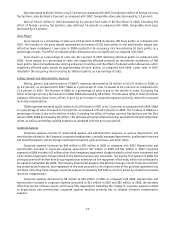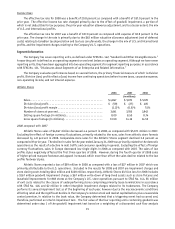Foot Locker 2008 Annual Report Download - page 21
Download and view the complete annual report
Please find page 21 of the 2008 Foot Locker annual report below. You can navigate through the pages in the report by either clicking on the pages listed below, or by using the keyword search tool below to find specific information within the annual report.5
Similar to others in our industry, the recent macroeconomic conditions have affected both our performance, as
well as our stock price and market capitalization, and it is difficult to predict how long these economic conditions will
continue, whether they will continue to deteriorate, and which aspects of our business may be adversely affected.
These conditions and the continuation of these conditions could affect the fair value of our long-lived assets, goodwill
and other intangible assets and could result in future impairment charges, which would adversely affect our results of
operations.
Material changes in the market value of the securities we hold may adversely affect our results of operations and
financial condition.
As of January 31, 2009, our cash, cash equivalents and short-term investments totaled $408 million, of which
$380 million was invested in a diversified portfolio of short-term securities. Substantially all of our investments
were short-term deposits in highly rated banking institutions. We regularly monitor our counterparty credit risk
and mitigate our exposure by making short-term investments only in highly-rated institutions and by limiting the
amount we invest in any one institution. At January 31, 2009, most of the investments were in institutions rated
“AA-” or better from a major credit rating agency. Despite those ratings, it is possible that the value or liquidity of
our investments may decline due to any number of factors, including general market conditions and bank-specific
credit issues. We have significant amounts of cash and cash equivalents at financial institutions that are in excess of
federally insured limits. With the current uncertain financial environment and the instability of financial institutions,
we cannot be assured that we will not experience losses on our deposits.
The master trust which holds the assets of our U.S. pension plan has assets totaling approximately $346 million
as of January 31, 2009. The fair values of these assets held in the master trust are compared to the plan’s projected
benefit obligation to determine the pension funding liability. We attempt to mitigate risk through diversification,
and we regularly monitor investment risk on our portfolio through quarterly investment portfolio reviews and periodic
asset and liability studies. Despite these measures, it is possible that the value of our portfolio may decline in the
future due to any number of factors, including general market conditions and credit issues. Such declines could have
an impact on the funded status of our pension plans and future funding requirements. In addition, the decline in our
pension assets will adversely affect pension expense in 2009.
Complications in our distribution centers and other factors affecting the distribution of merchandise may affect
our business.
We operate four distribution centers worldwide to support our athletic business. In addition to the distribution
centers that we operate, we have third-party arrangements to support our operations in Canada, Australia and New
Zealand. If complications arise with any facility or any facility is severely damaged or destroyed, the Company’s other
distribution centers may not be able to support the resulting additional distribution demands. This may adversely
affect our ability to deliver inventory on a timely basis. We depend upon UPS for shipment of a significant amount of
merchandise. An interruption in service by UPS for any reason could cause temporary disruptions in our business, a loss
of sales and profits, and other material adverse effects.
Our freight cost is affected by changes in fuel prices through surcharges. Increases in fuel prices and surcharges
and other factors may increase freight costs and thereby increase our cost of sales.
A major failure of our information systems could harm our business.
We depend on information systems to process transactions, manage inventory, operate our websites, purchase,
sell and ship goods on a timely basis, and maintain cost-efficient operations. Any material disruption or slowdown of
our systems could cause information to be lost or delayed, which could have a negative effect on our business. We
may experience operational problems with our information systems as a result of system failures, viruses, computer
“hackers” or other causes. We cannot be assured that our systems will be adequate to support future growth.
Risks associated with Internet operations.
Our Internet operations are subject to numerous risks, including risks related to the failure of the computer
systems that operate our websites and their related support systems, including computer viruses, telecommunications
failures and similar disruptions. Also, we may require additional capital in the future to sustain or grow our online
commerce.


